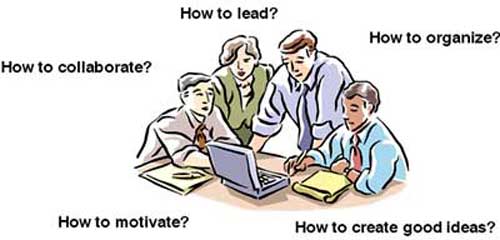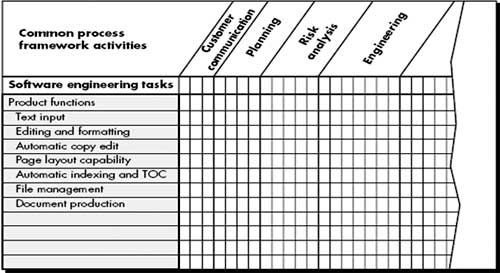Project Management Concepts
Sakshi Education

The performing a work involves a set of tasks to be operating in synchronous to achieve the project. This process involves the channelizing of resources to felicitate the task execution. When resources are involved, then a mechanism is required to streamline these resources to perform task execution in a disciplined way. This mechanism is termed as Management. To build a complex system like Software, lot of resources like time, money and people will be involved over a long duration; this necessity brings in the management principles for proper execution of software project.
As per the classical definition by Roger Pressmen, Project management involves the planning, monitoring, and control of the people, process, and events that occur as software evolves from a preliminary concept to an operational implementation.
Management Spectrum:
Effective project management focuses on four aspects of the project known as the 4 P’s:
People- The most important element of a successful project. Key areas for software people - recruiting, selection, performance management, training, compensation, career development, organization & work design, team/culture development.
Product- The software to be built (product objectives, scope, alternative solutions, constraint)
Process - The set of framework activities and software engineering tasks to get the job done (framework activities populated with tasks, milestones, work products, and QA points)
Project - All work required to make the product a reality. (Planning, monitoring, controlling)
Player of the project
The Product
The product is consists of two things:
Product Scope
Problem decomposition
Usually, we humans when encountered a problem have a tendency to decompose the problem in to segments and start thinking solution. In the same way in software development too, Problem decomposition is an act of segmenting problem in to various segments. It is also called partitioning or problem elaboration. Decomposition is applied in 2 major areas:
Software functions, described in the statement of scope, are evaluated and refined to provide more detail prior to the beginning of estimation. Once scope is defined, it is decomposed into part functions and user-visible data objects or into a set of problem classes. Decomposition process continues until all functions or problem classes have been defined and this further makes planning easier.
The Process
The definition, development and support are the major aspects of the software process. Process model chosen must be appropriate for the:
Once a process framework has been established, then determine the degree of thoroughness required and define a task set for each software engineering activity.
Task set =
Melding the Product and Process

Melding the Product and Process
Process decomposition
Process decomposition begins when the project manager tries to determine how to accomplish each activity.
E.g. A small, relatively simple project might require the following work tasks for the communication activity:
Now, we consider a more complex project, which has a broader scope and more significant business impact. Such a project might require the following work tasks for the customer communication activity:
The Project
Project - W5HH Approach
W5HH principle is applicable regardless of size or complexity of software project
In order to develop project plan, W5HH approach is more appropriate.
As per the classical definition by Roger Pressmen, Project management involves the planning, monitoring, and control of the people, process, and events that occur as software evolves from a preliminary concept to an operational implementation.
Management Spectrum:
Effective project management focuses on four aspects of the project known as the 4 P’s:
People- The most important element of a successful project. Key areas for software people - recruiting, selection, performance management, training, compensation, career development, organization & work design, team/culture development.
Product- The software to be built (product objectives, scope, alternative solutions, constraint)
Process - The set of framework activities and software engineering tasks to get the job done (framework activities populated with tasks, milestones, work products, and QA points)
Project - All work required to make the product a reality. (Planning, monitoring, controlling)
Player of the project
- The Stakeholders
- Team leaders
- The Software Team
- Coordination and Communication Issues.
- Stakeholders
- Senior managers who define the business issues that often have significant influence on the project.
- Project (technical) managers who must plan, motivate, organize, and control the practitioners who do software work.
- Practitioners who deliver the technical skills that are necessary to engineer a product or application.
- Customers who specify the requirements for the software to be engineered
- End-users who interact with the software once it is released for production use.
- Team Leaders
MOI model for leadership
- Motivation: The ability to encourage (by “push or pull”) technical people to produce to their best ability.
- Organization: The ability to mold existing processes (or invent new ones) that will enable the initial concept to be translated into a final product.
- Ideas or Innovation: The ability to encourage people to create and feel creative even when they must work within bounds established for a particular software product or application.
Characteristics of effective project managers (problem solving, managerial identity, achievement, influence and team building)
- Software Teams
The following factors must be considered when selecting a software project team structure:
- The difficulty of the problem to be solved
- The size of the resultant program(s) in lines of code or function points
- The time that the team will stay together (team lifetime)
- The degree to which the problem can be modularized
- The required quality and reliability of the system to be built
- The rigidity (hardness) of the delivery date
- The degree of sociability (communication) required for the project
“Organizational Paradigms” for software engineering team
a. Closed paradigm
Structures a team along a traditional hierarchy of authority. Such teams can work well when producing software that is quite similar to past efforts. So, Less likely to be innovative when working within the closed paradigm.
b. Random paradigm
Structures a team loosely and depends on individual initiative of the team members. When innovation or technological breakthrough is required, teams following the random paradigm will excel. It struggles when “orderly performance” is required.
c. Open paradigm
Structure a team in a manner that achieves some of the controls associated with the closed paradigm but also much of the innovation that occurs when using the random paradigm. Open paradigm team structures are well suited to the solution of complex problems but may not perform as efficiently as other teams.
d. Synchronous paradigm
Relies on the natural categorization of a problem and organizes team members to work on pieces of the problem with little active communication among themselves.
- Team Coordination & Communication
- Characteristics of modern software
- Scale, - development effort is high
- Uncertainty, - continuing stream of changes
- Interoperability - New software must communicate with existing software
Software engineering team must establish effective methods for coordinating the people who do the work. To accomplish this, mechanisms for formal and informal communication among team members and between multiple teams must be established. Formal communication is accomplished through “writing, structured meetings, and other relatively activities. Informal communication is more personal. Members of a software team share ideas on an ad hoc basis, ask for help as problems arise, and interact with one another on a daily basis.
The Product
The product is consists of two things:
- Software or product scope
- Problem decomposition.
Product Scope
- Software Scope: Scope is defined by answering the following questions:
- Context
How the software to be built does fit into a larger system, product, or business context.
What constraints are compulsory as a result of the context?
- Information objectives
What customer-visible data objects are produced as output from the software?
What data objects are required for input?
- Function and performance
What function does the software perform to transform input data into output?
Are any special performance characteristics to be addressed?
Software project scope must be unambiguous and understandable at the management and technical levels.
Problem decomposition
Usually, we humans when encountered a problem have a tendency to decompose the problem in to segments and start thinking solution. In the same way in software development too, Problem decomposition is an act of segmenting problem in to various segments. It is also called partitioning or problem elaboration. Decomposition is applied in 2 major areas:
- Functionality that must be delivered.
- Process that will be used to deliver it.
Software functions, described in the statement of scope, are evaluated and refined to provide more detail prior to the beginning of estimation. Once scope is defined, it is decomposed into part functions and user-visible data objects or into a set of problem classes. Decomposition process continues until all functions or problem classes have been defined and this further makes planning easier.
The Process
The definition, development and support are the major aspects of the software process. Process model chosen must be appropriate for the:
- the customers who have requested the product and the people who will do the work,
- Characteristics of the product itself, and
- Project development environment
Once a process framework has been established, then determine the degree of thoroughness required and define a task set for each software engineering activity.
Task set =
- Software engineering tasks
- Work products
- Quality assurance points
- Milestones
Melding the Product and Process

Melding the Product and Process
- Project planning begins with melding the product and the process
- Each function to be engineered must pass through the set of framework activities defined for a software organization
- Each major product function is listed in the left-hand column.
- Framework activities are listed in the top row.
- Software engineering work tasks would be entered in the following row.
- The job of the project manager is to estimate resource requirements for each matrix cell start and end dates for the tasks associated with each cell, and work products to be produced as a consequence of each task.
Process decomposition
Process decomposition begins when the project manager tries to determine how to accomplish each activity.
E.g. A small, relatively simple project might require the following work tasks for the communication activity:
- Develop list of clarification issues.
- Meet the customer to address clarification issues.
- Jointly develop a statement of scope.
- Review the statement of scope with all concerned.
- Modify the statement of scope as required.
Now, we consider a more complex project, which has a broader scope and more significant business impact. Such a project might require the following work tasks for the customer communication activity:
- Review the customer request.
- Plan and schedule a formal, facilitated meeting with the customer.
- Conduct research to specify the proposed solution and existing approaches.
- Prepare a “working document” and an agenda for the formal meeting.
- Jointly develop mini-specs that reflect data, function, and behavioral features of the software.
- Review each mini-spec for correctness, consistency, and lack of ambiguity.
- Assemble the mini-specs into a scoping document.
- Review the scoping document with all concerned.
- Modify the scoping document as required.
The Project
- Projects get into jeopardy when …
- Software people don’t understand their customer’s needs.
- The product scope is poorly defined.
- Changes are managed poorly.
- The chosen technology changes.
- Business needs change [or are ill-defined].
- Deadlines are unrealistic.
- Users are opposing.
- The project team lacks people with appropriate skills.
- Managers [and developers] avoid best practices and lessons learned.
Project - W5HH Approach
- Approach (W5HH) that addresses project objectives, milestones and schedules, responsibilities, management and technical approaches, and required resources.
- Enables all parties to evaluate the validity of business reasons for the software work.
What will be done? - Establish the task set that will be required.
When will it be accomplished? - Establish a project schedule by identifying key project tasks to achieve milestone.
Who is responsible? - Role and responsibility of each member.
Where are they organizationally located? - Not only software team itself. Customer, end user and other stakeholders also have responsibility.
How will the job be done technically and managerially? - Once product scope is established, a management and technical strategy for the project must be defined.
How much of each resource is needed? - Develop estimation.
Why is the system being developed?
W5HH principle is applicable regardless of size or complexity of software project
In order to develop project plan, W5HH approach is more appropriate.
Published date : 28 Apr 2015 02:25PM






